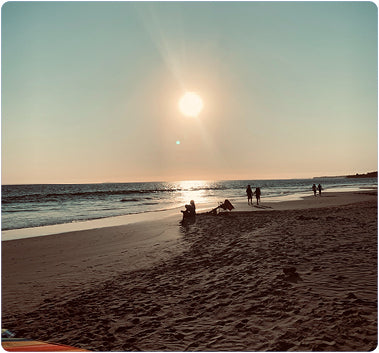Sun Protection Facts

Sun Protection Facts
THE IMPORTANCE OF WEARING SUN-PROTECTIVE CLOTHING
Your clothing absorbs or blocks harmful UV radiation and remains one of the most effective forms of protection against sun damage and skin cancer. Besides, sun-protective clothing is the simplest way to stay safe; unlike sunscreen, you never need to reapply it.
WHY HATS ARE A MUST
Basal cell and squamous cell carcinomas account for about 90 percent of all skin cancers, and often appear on the head and neck. Hats help safeguard your face, scalp and neck, that is why is so important to complete your outfit with a hat.
OUR SUN-PROTECTIVE CLOTHING ESSENTIALS
- Rash top
- Surf suit bashie
- Beach shorts or wanderpants
- Sun hat
- Sunglasses
- Sun blanket
NOT ALL CLOTHING PROTECTS EQUALLY
The average white cotton T-shirt is around UPF 7. When that T-shirt gets wet, it provides a UPF of only 3. Our clothing UPF50+ blocks 98% of UVA/UVB rays, wet or dry. You can enjoy yourself in the sun without compromising your health or style by wearing trendy sun-safe clothing, hats and sunglasses as part of a complete sun protection strategy.
TAKE SPECIAL CARE OF THE LITTLE ONES
In the first six months, it is advisable to keep infants out of the sun. Clothing should cover the baby’s vulnerable arms and legs, and don’t forget to use hats, sunglasses and stroller sun shade/UV blanket when you’re on the move. For toddlers, in addition to providing protective clothing and hat, you can apply sunscreen starting at six months (preferably a mineral sunscreen). Children need to be taught about the dangers of too much sun exposure as they become more independent. If you or your child burn easily, be extra careful to cover up, limit exposure and apply sunscreen.
SPF MEANING
SPF stands for Sun Protection Factor and is used to rate sunscreen products. SPF is a measure of how well a sunscreen will protect the skin from UVB rays. SPF 15 filters out approximately 93 percent of all incoming UVB rays, SPF 30 keeps out 97 percent and SPF 50 keep out 98 percent. SPF provides only UVB protection (unless stated as a broad spectrum sunscreen).
UPF MEANING
UPF stands for Ultraviolet Protection Factor and it indicates how much UV radiation (both UVB and UVA) a fabric allows to reach your skin. UPF provides UVA and UVB protection. For example, a UPF 50 fabric blocks 98% of the sun’s rays and allows 2% percent to penetrate it, thus reducing your exposure risk significantly.
UVA/UVB MEANING
UVA rays penetrate deeper tissues of the skin and are the main cause of early skin aging signs, such as wrinkles, loose skin and sun spots.
UVB rays cause sunburn, chronic skin damage, preliminary stages of cancer, and, eventually, skin cancer itself.
Both UVA and UVB rays cause DNA damage, which greatly increases skin cancer risk.
DO YOUR SELF EXAM REGULARLY AND VISIT YOUR DERMATOLOGIST ANNUALLY FOR A SKIN EXAM
Finding skin cancer at an early stage is crucial; early detection can vastly increase your chances of cure. Keep an eye on the ugly duckling sign, look for anything new, changing, or unusual on both sun-exposed and sun-protected areas of the body. When in doubt, check it out and visit your dermatologist for a professional skin exam.

More Facts

Skin cancer is the world's most common cancer with over 1,000,000 non-melanoma and almost 300,000 melanoma cases a year

One blistering sunburn in childhood or adolescence more than doubles a person’s chances of developing melanoma later in life

90% of non-melanoma skin cancers and 86% of melanomas are associated with exposure to ultraviolet (UV) radiation from the sun

In the past decade, the number of new invasive melanoma cases diagnosed annually increased by 44%, with deaths increasing by 32%

It is estimated that 90% of skin aging is caused by the sun

The best ways to keep infants sun safe are with shade and clothing. Clothing is the first line of defense against skin cancer
Sources: Skin Cancer Foundation (SCF); American Cancer Society (ACS); Global Cancer Observatory (GCO); Associação Portuguesa de Cancro Cutâneo (APCC)









